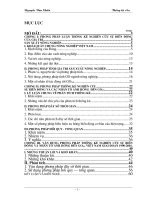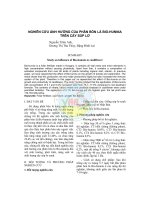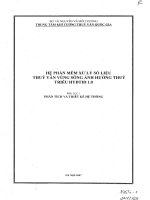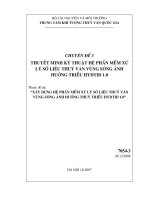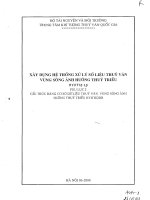Ảnh hưởng của lãi suất đến giá trị xuất khẩu nông nghiệp việt nam
Bạn đang xem bản rút gọn của tài liệu. Xem và tải ngay bản đầy đủ của tài liệu tại đây (1.51 MB, 81 trang )
DANANG UNIVERSITY
DANANG UNIVERSITY OF ECONOMICS
INTERNATIONAL BUSINESS DEPARTMENT
BACHELOR’S THESIS:
ASSESSING THE INFLUENCE OF EXCHANGE
RATE ON VIETNAMESE AGRICULTURAL
EXPORT VALUE
GRADUATION THESIS
Da Nang, 05/2022
DANANG UNIVERSITY
DANANG UNIVERSITY OF ECONOMICS
INTERNATIONAL BUSINESS DEPARTMENT
BACHELOR’S THESIS
ASSESSING THE INFLUENCE OF EXCHANGE
RATE ON VIETNAMESE AGRICULTURAL
Major
: INTERNATIONAL BUSINESS
Instructors
: NGUYEN THI THUY - DOCTOR
Author
: HO THANH BAO
Class
: 44K01.1
GRADUATION THESIS
Da Nang, 05/2022
SUMMARY OF THE GRADUATION THESIS
The goal of this article is to assess the impact of the EUR/VND exchange rate on the
value of Vietnamese agricultural major goods exported to the EU market (EVN) using
the Cointegration test, the Granger causality test, and the VAR/VEC model. The findings
show that there is only one co-integrating equation between two variables. It means that
the exchange rate has an effect on EVN in the long run. Furthermore, in the short run,
there is one Granger causality relationship between the VND/USD exchange rate and the
EVN, but not vice versa. Overall, the impact of the EUR/VND exchange rate on the
value of Vietnamese agricultural major products exported to the EU market (EVN) has
been thoroughly examined in this study using novel methodologies. The findings in this
study will be highly useful for Vietnamese farmers, exporters, and stakeholders in
investment and risk management, as well as the Vietnam government in policymaking.
APPRECIATION
First, the author would like to thank the teachers of Danang University of Economics for
the knowledge that they have equipped the author to serve well for this graduation thesis.
In particular, the author would like to especially express his deep respect and gratitude
to the scientific guide - Dr. Nguyen Thi Thuy, who wholeheartedly guided and helped
the author during the process of choosing the topic, Outline, finalize and edit the article.
I would also like to thank all of my friends and family for their ongoing support and
understanding while I was conducting research and composing my project.
And finally, I would love to give my honest appreciation toward Tra Lien, who has given
me the efford to keep on going and try my best to fulfill my thesis at the end.
GUARANTEE
I hereby declare that the topic "ASSESSING THE INFLUENCE OF EXCHANGE
RATE ON VIETNAMESE AGRICULTURAL" is my independent research work under
the guidance of my instructor: Dr. Nguyen Thi Thuy. Actual research content is not
copied from others. The topic and content of the internship report are products that I have
researched with great effort during my study at the school. The data and results presented
in the report are completely honest, I would like to take full responsibility and discipline
of the subject and the school if there is a problem.
Da Nang, 24/05/2022
Author
(Signature with full name)
Ho Thanh Bao
INSTRUCTOR’S COMMENT
...........................................................................................................................................
...........................................................................................................................................
...........................................................................................................................................
...........................................................................................................................................
...........................................................................................................................................
...........................................................................................................................................
...........................................................................................................................................
...........................................................................................................................................
...........................................................................................................................................
...........................................................................................................................................
...........................................................................................................................................
...........................................................................................................................................
...........................................................................................................................................
...........................................................................................................................................
...........................................................................................................................................
...........................................................................................................................................
...........................................................................................................................................
Da Nang, 24/05/2022
Instructor
REVIEW LECTURER’S COMMENT
...........................................................................................................................................
...........................................................................................................................................
...........................................................................................................................................
...........................................................................................................................................
...........................................................................................................................................
...........................................................................................................................................
...........................................................................................................................................
...........................................................................................................................................
...........................................................................................................................................
...........................................................................................................................................
...........................................................................................................................................
...........................................................................................................................................
...........................................................................................................................................
...........................................................................................................................................
...........................................................................................................................................
...........................................................................................................................................
...........................................................................................................................................
Da Nang, 24/05/2022
Review lecturer
TABLE OF CONTENTS
LIST OF ACRONYMS .................................................................................................... i
LIST OF TABLES .......................................................................................................... ii
LIST OF FIGURES ........................................................................................................ iii
INTRODUCTION ........................................................................................................... 1
1. Abstract ................................................................................................................. 1
2. Research background and rational ........................................................................ 1
3. Research objectives ............................................................................................... 3
Research aims............................................................................................................... 3
Research objectives ...................................................................................................... 3
Research Questions ...................................................................................................... 4
The scope of the research ............................................................................................. 4
Research method .......................................................................................................... 4
Research structure ........................................................................................................ 4
CHAPTER 1. Literature review ...................................................................................... 6
1.1. Overview of agricultural products and agricutural products export ..................... 6
1.1.1. Overview of agricultural products .................................................................. 6
1.1.1.1. Definition.................................................................................................. 6
1.1.1.2. Characteristics of agricultural products.................................................... 8
1.1.2. Overview of agricultural products export ....................................................... 9
1.1.2.1. Some theories of international trade......................................................... 9
a. The theory of comparative advantage ............................................................ 9
b. Heckcher-Ohlin Theory ............................................................................... 11
1.1.2.2. Definition and the importance of agricultural products export .............. 12
a. Definition of agricultural products export ................................................... 12
b. Role of agricultural products export in Vietnam’s economy....................... 13
1.2. Overview of exchange rate. ................................................................................ 15
1.2.1. Definition of Exchange rate. ......................................................................... 15
1.2.2. Types of exchange rate. ................................................................................ 15
1.2.2.1. Based on the object to determine the exchange rate .............................. 15
a. Official exchange rate .................................................................................. 15
b. Market exchange rate ................................................................................... 16
1.2.2.2. Based on payment term .......................................................................... 16
a. Spot exchange rate ....................................................................................... 16
b. Forwards exchange rate ............................................................................... 16
1.2.2.3. Based on the value of the exchange rate ................................................ 16
a. Nominal exchange rate (NER) ..................................................................... 16
b. Real Exchange rate (RER) ........................................................................... 16
1.3. Literature review of domestic and abroad researches ......................................... 17
1.3.1. Literature review of abroad researches. ........................................................ 17
1.3.2. Literature review of domestic researches. .................................................... 18
CHAPTER 2. RESEARCH METHODOLOGY ........................................................... 20
2.1. Research objectives - Research questions ........................................................... 20
2.2. Research hypothesis. ........................................................................................... 20
2.3. Research methodology ........................................................................................ 22
2.3.1. Research methodology.................................................................................. 22
2.3.2. Data collection .............................................................................................. 22
2.3.3. Data processing method ................................................................................ 25
2.3.3.1. Unit root test ........................................................................................... 25
2.3.3.2. Co-intergration test ................................................................................. 25
2.3.3.3. Causality test .......................................................................................... 26
2.3.3.4. VAR model and VEC model .................................................................. 27
2.3.3.5. Evaluation of reliability and accuracy data sources ............................... 28
CHAPTER 3. Research results ...................................................................................... 32
3.1. Situation of Vietnam’s agricultural products export. .......................................... 32
3.1.1. Situation of Vietnam’s agricultural products export in the period 2015-2019.
................................................................................................................................ 32
3.1.2. Situation of Vietnam’s agricultural main products export to the EU market in
the period 2015-2019. ............................................................................................. 33
3.2. Situation of EUR/VND exchange rate in the period of 2015-2019. ................... 40
3.3. The influence of EUR/VND exchange rate (Ex) on Vietnamese agricultural main
products exports (EVN) to the EU market. ................................................................ 40
3.3.1. Unit root test ................................................................................................. 40
3.3.2. Co-intergration test ....................................................................................... 43
3.3.3. Determine the lag length upon VAR model ................................................. 44
3.3.4. Vector Error Correction Model (VEC model). ............................................. 45
3.3.5. Vector Autoregressive model (VAR model) ................................................ 47
3.3.6. Granger causality test ................................................................................... 50
CHAPTER 4. Conclusion and some recommendations ................................................ 52
4.1. Conclusions ......................................................................................................... 52
4.2. Some recommendations to improve Vietnamese agricultural products export to
the EU market and enhance competitiveness of Vietnamese agricultural industry. .. 53
4.2.1. For the government ....................................................................................... 53
4.2.2. For domestic enterprises ............................................................................... 54
4.3. Limitations of the research and future research development ............................ 55
References ..................................................................................................................... 57
APPENDIX ................................................................................................................... 61
LIST OF ACRONYMS
ADF
Augmented Dickey–Fuller
ASEAN
Association of South East Asian Nations
EU
European Union
IMF
International Monetary Fund
ITC
International Trade Centre
MLR
Multiple Linear Regression
SITC rev.3
Standard International Trade Classification Revision 3
VAR
Vector Autoregression
VCCI
Vietnam Chamber of Commerce and Industry
VEC
Vetor Error Corection
WB
World Bank
WTO
World Trade Organization
i
LIST OF TABLES
Table 2-1 Summary of some related literature review .................................................. 20
Table 2-2 Research data sources ................................................................................... 23
Table 2-3 Descriptive staticstics .................................................................................... 23
Table 2-4 Data source annotation .................................................................................. 28
Table 2-5 Reliability and accuracy of data sources ....................................................... 29
Table 3-1 ADF stationary test ....................................................................................... 42
Table 3-2 Unrestricted Cointegration Rank Test (Trace) .............................................. 43
Table 3-3 Unrestricted Cointegration Rank Test (Maximum Eigenvalue) ................... 43
Table 3-4 Determine the lag length ............................................................................... 44
Table 3-5 Vetor Error Correction model results ........................................................... 45
Table 3-6 Vector Autoregressive model results ........................................................... 47
Table 3-7 Granger Causality test results ....................................................................... 50
ii
LIST OF FIGURES
Figure 1.1. Vietnam's agricultural main products total export over the period of 20092018. .............................................................................................................................. 13
Figure 1.2 Number of agricultural enterprises in the period 2016-2020. ...................... 14
Figure 3.1 Vietnam’s agricultural main products export to the EU market in the period
2015-2019 ...................................................................................................................... 33
Figure 3.2 Vietnam's coffee export to EU market in 2015-2019. ................................. 34
Figure 3.3 Vietnam's pepper export to EU market in 2015-2019. ................................ 35
Figure 3.4 Vietnam's vegetables export to EU market in 2015-2019. .......................... 36
Figure 3.5 Vietnam's rice export to EU market in 2015-2019. ..................................... 37
Figure 3.6 Vietnam's tea export to EU market in 2015-2019........................................ 38
Figure 3.7 Vietnam's rubber export to EU market in 2015-2019. ................................. 39
Figure 3.8 EUR/VND exchange rate in the period of 2015-2019 ................................. 40
Figure 3.9 log-log equation of EUR/VND exchange rate and Vietnamese agricultural
main products export value to EU market in 2015-2019. ............................................. 41
iii
INTRODUCTION
1.
Abstract
The goal of this article is aiming to assess the impact of the EUR/VND exchange rate on
the value of Vietnamese agricultural major goods exported to the EU market (EVN)
using the Johansen’s cointegration test, the Causality test Granger model, and the
VAR/VEC model. The results indicate that there is one cointegrating equation between
the two selected variables. It means that the exchange rate has an influence on EVN in
the long-term. While, in the short run, Granger causality relationship is confirmed to be
existed between the EUR/VND exchange rate and the EVN, but not in the opposite
direction. Overall, the impact of EUR/VND exchange rate on the value of Vietnamese
agricultural major products exported to the EU market (EVN) has been thoroughly
examined in this study using novel methodologies. The findings in this study will be
highly useful for Vietnamese farmers, exporters, and stakeholders in investment and risk
management, as well as the Vietnam government in policymaking.
Keyword: Cointegration test, VAR/VEC model, Granger Causality test, EUR/VND
exchange rate. Vietnamese agricultural main products.
2.
Research background and rational
Agricultural, one of the most significant links in the Vietnamese economy, is a simple
labor-intensive stage that often takes use of cheap labor prices and land in countries with
sufficient labor resources. As a result, agricultural development is generally rapid and
efficient in developing countries in the early phases of industrialisation, such as Vietnam.
In contrast, industrialized countries with high levels of technology have high labor costs,
resulting in a poor level of agricultural competitiveness. As a result, these countries tend
to gravitate toward industries with more technical content, lower labor requirements, and
higher profitability. In other words, Agricultural can promote its position in emerging
1
countries with favorable conditions, like as Vietnam, due to comparative advantages in
human resources, land, and labor prices.
Vietnam is still predominantly an agricultural country, and agricultural exports play a
critical role in fostering social stability and improving farmers' quality of life,
contributing to the country's economic progress. With the present agricultural goods and
the same potential in terms of natural and social factors, Vietnam intends to be among
the top 5 agricultural product exporters in the world.
During the period of 5 years from 2015 to 2019, Vietnam agricultural products export to
EU market was almost paralle with the direction of EUR/VND exchange rate and
steadily increase from 1.3 billion Euro in 2015 to more then 1.5 billion Euro in 2019,
while the exchange rate increase from nearly 24000 VND/EUR in 2015 to 25990
VND/EUR in 2019. According to State Bank of Vietnam Decision No. 2730/Q-NHNN
dated December 31, 2015, there is only acception for 3% or less in the fluctuation of the
exchange rate daily. Thus, the government controls the EUR/VND exchange rate;
nonetheless, with a total export value of more than EUR 1.5 billion per year, even a little
shift in currency rate might pose a significant risk to exporting firms and farmers.
Based on this context, a deep understanding of the influence of the EUR/VND exchange
rate on agricultural commodities export value in general, and agricultural main
commodities export value to the EU market in particular, is critical for firms, farmers,
and the Vietnamese government, since it aids in better characterizing the transmission
mechanism of the influence of exchange rates on Vietnamese agricultural main products
export value to the EU market.
Xie et al. (2008), Rahman and Serletis (2009), Doganlar (2002) and others have
conducted extensive research on the relationship between the exchange rate and foreign
trade or export as well as Cheung and Sengupta (2013), Buguk et al. (2003). There are
just a few studies by Vietnamese scholars on the impact of exchange rates on main
products export value in general, and Vietnamese main products export value to EU
2
market in particular. The Multiple Linear Regression (MLR) model are the key
methodologies used in these publications. According to Granger and Newbold (1974),
Hamilton (1994), Ferson et al. (2003), and Mccallum (2010), the most significant
shortcoming of MLR models for estimating time series data is false regression if ,at the
level, the variables are not stationary.
In this regard, the study “ASSESSING THE INFLUENCE OF EXCHANGE RATE ON
VIETNAMESE AGRICULTURAL” will re-examine this issue. By using Cointegration
test, VAR/VEC model, and Granger causality test, this research aims to analyze the
impact of EUR/VND exchange rate on Vietnamese agricultural main product export
value to EU market in the period of 2015-2019. Finally, with the results of all of the
above model, several recommendations and solutions will be proposed to promote
exports of the Vietnamese agricultural main product export value to EU market.
3.
Research objectives
Research aims
This research aims to (1) analyze the impact of the EUR/VND exchange rate on the
export value of Vietnamese agricultural main product export value to EU market during
the period from 2015 to 2019; (2) give several recommendations to better exploit the
agricultural main product export value to EU market in the next period.
Research objectives
The research consists of four specific objectives. Firstly, this study clarifies the current
situation of EUR/VND exchange rate and Vietnamese agricultural main product (Rice,
Pepper, Tea, Coffee, Vegetables, Rubber) export value to EU market in the period of
2015-2019. Secondly, conducting Cointergration test, Causality test, VAR and VEC
model to signify the influence of these two selected variables. Finally, from the above
analysis, some recommendations which exploit and promote the export value of
Vietnamese agricultural main product export to EU market in the next period are
proposed.
3
Research Questions
RQ1: What is the situation of Vietnamese agricultural main product export to EU market
and EUR/VND exchange rate in the period of 2015-2019?
RQ2: How does the EUR/VND exchange rate influence the Vietnamese agricultural
main product export to EU market in the period of 2015-2019?
RQ3: What could be the policies and solutions to boost Vietnamese agricultural main
product export to EU market in the next period?
The scope of the research
According to research subjects, the study focuses on analyzing the Vietnamese
agricultural main product value which includes rice, coffee, pepper, tea, rubber,
vegetables in the five-year period from 2015 to 2019. As for the scope of this research,
the paper aims to estimate export value of Vietnamese agricultural main product export
to EU in the given period.
Research method
Quantitative research method is considered to be most suitable with the research
objectives, based on secondary data. Through the application of quantitative methods,
namely Cointegration test, VAR/VEC model, and Granger causality test, the impact of
EUR/VND exchange rate on Vietnamese agricultural main product export to EU market
will be indicated and reflected in the form of metrics and statistics.
Research structure
This research has four chapters in addition to the Introduction, Conclusion, Appendix,
and References:
Chapter 1: Literature review. Based on our analysis of prior relevant works, we propose
a definition of agricultural products and agricultural product export, as well as a
cointergration model, causality test, VAR and VEC model. The proposed research model
4
is then highlighted through the evaluation and discovery of fresh points, as well as the
inheritance from previous inquiries.
Chapter 2: To address the research questions, research hypotheses are established in
this chapter. Furthermore, a quantitative study approach is used to evaluate the effect of
the EUR/VND exchange rate on the export value of agricultural major products to the
EU market. Data for research is gathered from reliable sources, verified by international
organizations, and then run via Johansen's Cointegration test, VAR/VEC model, and
Granger causality test.
Chapter 3: Research results. The findings are shown in a panel table to show the impact
of the EUR/VND exchange rate on the export value of agricultural major goods to the
EU market from 2015 to 2019.
Chapter 4: Conclusions and recommendations. Prior to the topic-based development
suggestion, the limits of this article are clarified. To increase export value and industry
competitiveness, a framework of solutions based on Vietnam's export situation is
suggested.
5
CHAPTER 1. LITERATURE REVIEW
1.1. Overview of agricultural products and agricutural products export
1.1.1. Overview of agricultural products
1.1.1.1. Definition
Agricultural products in the simple sense are groups of products produced based on
horticulture such as crops, poultry, livestock, etc. In order to define more accurately,
serving the research object, the author in turn approaches the concepts of agricultural
products given by different organizations and countries.
According to World Trade Organisation (WTO)
According to the WTO's agricultural agreement, agricultural products are all products
listed from chapters I to XXIV and some specific products of other schools in the HS
code system (except fish and fish products).
Therefore, agricultural products include:
Basic agricultural products such as rice, wheat, flour, milk, live animals, coffee,
pepper, cashews, tea, fresh vegetables, ...
Derivative products such as bread, butter, cooking oil, meat, ...
Products processed from agricultural products such as confectionery, dairy
products, sausages, soft drinks, wine, beer, tobacco, cotton fibers, raw animal
skins,...
From the perspective of the European Union (EU)
Although the EU does not specify which "agricultural products" are in any jurisdiction,
the European Commission's Trade Directorate (DG Trade) makes a list of what is
6
considered as an agricultural product based on the Standard International Trade
Classification Revision 3 (SITC rev.3) as follows:
o 0 - Food and live animals
o 1 - Beverages and cigarettes
o 21 - Hides, skins and furskins, raw
o 22 - Oil seeds and oleaginous fruits
o 231 - Natural rubber & similar gums, in primary forms
o 24 - Cork and wood
o 261 – Silk
o 263 – Cotton
o 264 - Jute, other textile bast fibre, n.e.s., not spun; tow
o 265 - Vegetable textile fibres, not spun; waste of them
o 29 - Crude animal and vegetable materials, n.e.s.
o 4 - Animal and vegetable oils, fats and waxes
According to General Department of Vietnam Customs
Currently, there is no legal source of Vietnam to clearly define the concept of
"agricultural products". However, according to the criteria of the General Department of
Vietnam Customs used in the Statistical Report 2020, items such as vegetables and fruits,
cashew nuts, coffee, tea, pepper, rice, rubber, cassava and products made from cassava
are counted as agricultural products.
7
Summarizing the above points of view, agricultural products can be understood as
"products of agricultural production activities, including finished or semi-finished
products, obtained from plants and animals or the growth of plants and animals.
(excluding products of the forestry and fishery industries)". (Ngo Thi My, 2016)
1.1.1.2. Characteristics of agricultural products
Perishable products, need to be preserved
Most agricultural products are perishable, but the duration of spoilage varies between
crops. Some agricultural products spoil in less time and others can still be used for a
while. Milk, meat, fruits, vegetables, ... stay fresh but only for a short time, so they are
easily spoiled. These products must be brought to market as quickly as possible. Special
refrigeration is required to keep these products safe and fresh. Food crops, grains such
as rice, wheat, mustard, ... can still be used for a long time.
Seasonality
Most agricultural products are only be produced in certain seasons. food crops such as
maize, rice, wheat; Food crops such as sugarcane, tobacco, jute and vegetables, potatoes
and fruits are produced in certain seasons. But some products such as fish, eggs, ... can
be produced in all seasons. Therefore, seasonal products can affect the agricultural
market.
Dispersed production
With the exception of some products that can only be produced in a particular region,
most agricultural products are produced in all regions of the country. As farmers are
scattered in different parts of the country, middlemen collect agricultural products and
supply them to the market.
Bulky
8
Most agricultural products are heavy and bulky. Therefore, the cost of transportation and
storage is higher than the value of these products.
Diversity in quantity and quality
The quality and quantity of agricultural products vary with soil productivity, season and
climate. Seed quality, fertilizer use, ... also make a difference in quality.
1.1.2. Overview of agricultural products export
1.1.2.1. Some theories of international trade
a. The theory of comparative advantage
David Ricardo (1772 - 1823) was an outstanding representative of classical bourgeois
political economy. He left behind a theory that has profound influence in his time as well
as has practical value today, which is comparative advantage.
This theory was developed based on the absolute view of Adam Smith. Accordingly,
Ricardo emphasized that countries that have an absolute advantage over all other
countries or do not have an absolute advantage over other countries in the production of
all products can still benefit from foreign trade. Countries can still participate in the
division of labor and international trade because each country has a comparative
advantage in the production of certain products. By specializing in the production and
export of products in which a country has a comparative advantage, world production
and consumption will increase, resulting in each country benefiting from trading. Thus,
comparative advantage is the basis for countries to trade with each other and is the basis
for the international division of labor.
David Ricardo builds a model of comparative advantage based on several hypotheses:
Analysis of the pattern of trade with two countries and two product categories;
Factors of production are not outwardly displaced;
9
The technology of the two countries is the same;
Perfectly competitive market;
Production cost is fixed;
Zero shipping cost;
Full employment of workers;
Advantages:
Solve the cause of international trade.
Explain the formation of trade relations between two countries
without any absolute advantage.
Disadvantages:
Hypothesize that specialization is absolute.
Unforeseeable case of equilibrium advantage.
Revealed comparative advantage (RCA)
In 1965, Bela Balassa first mentioned RCA to measure the degree of comparative
advantage of one product over another, one country over another. Until now, RCA has
been used as an indicator used to measure comparative advantage.
The RCA is determined by the following formula:
RCA = (Exa/EA):(Exw/Ew)
Where:
RCA
Revealed Compartive Advantage
10
